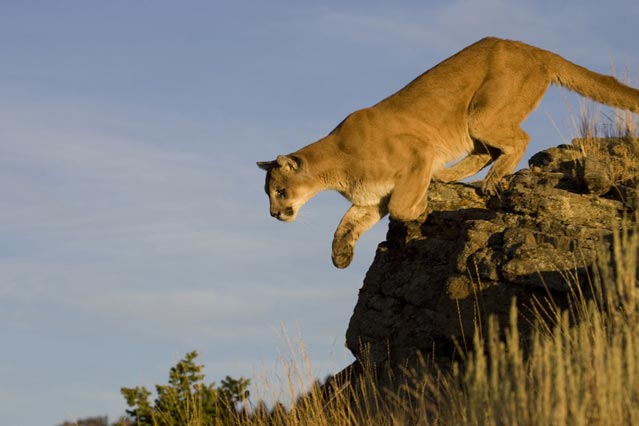Sometimes, having a little fun in mother nature can turn deadly. But if you’re quick to react appropriately (or luck is on your side) you can beat the odds. These four did. Here are their stories.
- Alone on the Water
- Caught in an Avalanche
- Falling Through Ice
- Mauled by a Cougar (And Saved by a Bear)
: Alone on the Water
Help is coming. In two more days.
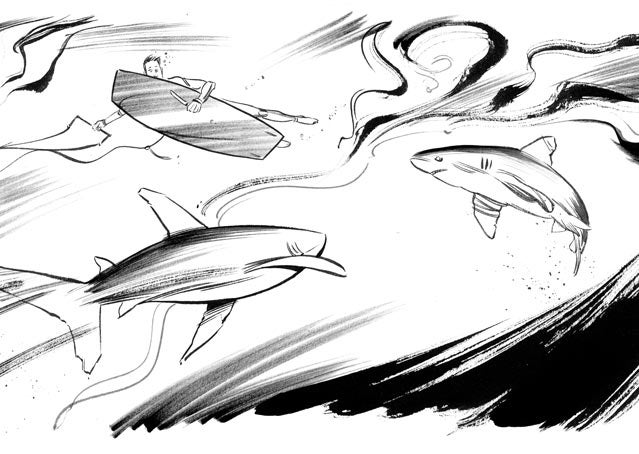
The most terrifying thing about sharks is how silent their approach is. It was 1 a.m., and for 40 hours I’d been stranded on my kiteboard in the Red Sea, waiting for the wind to pick up.
Last year I completed the first-ever kiteboard crossing of the Baltic Sea, and this time I was trying to cross the Red Sea, a 124-mile trip from Egypt to Saudi Arabia. Everything looked perfect. The sun was shining, my weather team predicted consistent northwest winds at 25 to 28 knots the entire way, and I had packed light.
But after eight hours of steady cruising, just 18 miles from the Saudi coast, the wind shut off like someone unplugged it. I triggered my SOS device and hoped to be rescued.
It was night in whitetip shark territory when the first two appeared, circling me at a distance. I was a sitting duck.
I spread the kite out to appear bigger and climbed on top of it, praying they’d leave me alone. I watched them take bites out of the nylon. I knew I was the next course and switched into survival mode. I tied the nine-inch tactical knife to my right hand so I wouldn’t drop it and prepared for battle.
For the next seven hours I was on full alert, using my board as a shield and stabbing the sharks under the dorsal fin each time they circled by. Their skin is incredibly thick, and you can feel their massive power gliding by, like a truck coasting in neutral. When they started attacking me from underneath I got aggressive, with jabs to the head and face. I’d heard the nose was sensitive, so I went for that when I could. The water was churning furiously all around me.
Once I scared the first two away, my confidence was high, which was good, because more came. Eleven in all. Some were light gray, some were black, others had stripes, and all were ugly. I fought them off until sunrise.
Later that day, the Saudi coast guard finally showed up, 50 hours after I sent out my SOS.
—AS TOLD TO SCOTT YORKO
FIVE ALIVE: WINNING A SHARK FIGHT
Expert advice from George Burgess, director of the Florida Program for Shark Research
1. Get big. Show the shark you’re as big and aggressive as it is. You don’t want to play dead; you want to yell and fight back.
2. Arm yourself. Sharkskin is extremely coarse and can easily cut yours, which you want to avoid. (Blood triggers sharks’ predatory instincts.) Use whatever you’ve got—flipper, camera, knife—to repeatedly jab the shark in the head, ideally in the nose, gills, or eyeballs.
3. Use karate. Open-palm shots to the shark’s nose are most effective, because they transfer momentum better than closed-fist punches. They also deflect upward, whereas punching has a natural downward trajectory that’s likely to follow through into the shark’s mouth.
4. Get a good angle. If you’re scuba diving, back up against a reef or a wall to reduce the angle of attack. Attacks from below are the hardest to defend.
5. Don’t panic. Sharks know easy prey when they see it, so don’t thrash or swim irregularly. Get out of the situation as gracefully as possible.
: Caught in an Avalanche
Living through a slide is just the beginning
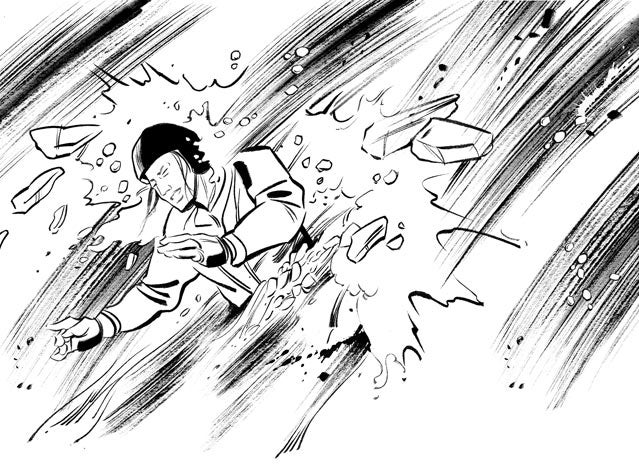
The first question my good friend Conrad Anker asked me when I told him about the avalanche was “When did you decide to live?” I knew the moment.
It was April 11 last spring, and I was in the Tetons scouting locations for a film shoot with and , two of the world’s best big-mountain snowboarders. Maybe 10 seconds after I’d dropped into my line, the entire mountain seemed to release. The avalanche grew until it was like an ocean, with waves of snow ripping down the slope and snapping off trees at the base.
I kicked my skis off and was swept over a cliff. When I landed, I was plunged deep under the still-sliding avalanche. The pressure crushed me. I felt as though I’d left my body; I seemed to be watching myself from afar. It was suddenly calm, and I had the rational and impersonal thought that this—here, now—is how I die. Then I realized that if I’m conscious and having this internal discussion, I must be alive. I decided to fight. The world came rushing back with the roar of the avalanche, and I tensed every muscle in my body against the pressure.
Two thousand feet later, I came to a stop, buried up to my chest on the valley floor. In the moments after, my priorities—family, friends, ambitions—were stacked with clarity. Four days later, I was supposed to fly to Nepal to join an expedition to ski the world’s fourth-highest peak. I decided not to go. I was beaten down and ashamed.
I dropped out of my normal life and went to Mexico to surf for four weeks. Looking back, I was struggling with post-traumatic stress. I was on edge for months. If I didn’t have two other expeditions in the works, I might have stayed in Mexico for 10 years. A month later, I climbed and skied Denali, and three months after that I finally completed the first ascent of India’s Shark’s Fin, one of the hardest climbs of my career. I’m not saying I wiped the slate clean after what happened—that experience goes everywhere I go. But working in the mountains isn’t just my job; it’s what I live for.
—AS TOLD TO KYLE DICKMAN
THE MENTAL SIDE OF ADVENTURE TRAUMA
Expert advice from Laurence Gonzales, author of Deep Survival: Who Lives, Who Dies, and Why
1. Recognize that there’s a problem and that it’s totally normal. The causes of post-traumatic stress range from extreme—combat survival—to common, like losing a loved one. Telltale symptoms include difficulty concentrating, sleeplessness, and jumpiness.
2. Take time. It used to be that combat veterans were forced to discuss the incident immediately after a trauma occurred. That caused suicides. The new rule is to talk to people you trust and not to force it.
3. Distract yourself. Post-traumatic stress is like being stuck in survival mode. Override that instinct through rhythmic, goal-oriented activities like writing, surfing, or knitting. (Who wouldn’t want a crocheted hat made by Jimmy Chin?)
4. Create rituals. Structure your emotional response, and allow yourself to feel bad about an incident one day a year—not the whole year. On January 23, 1945, my dad was shot down and survived a 27,000-foot fall in his airplane. When I was a kid, my family held a special dinner every January 23.
5. Rewire your brain. Repeated positive exposure overrides negative feelings. Cut your finger chopping onions? Chop more onions. Just be slow, deliberate, and very aware while you’re doing it.
: Falling Through Ice
Sometimes it pays to watch the instructional video
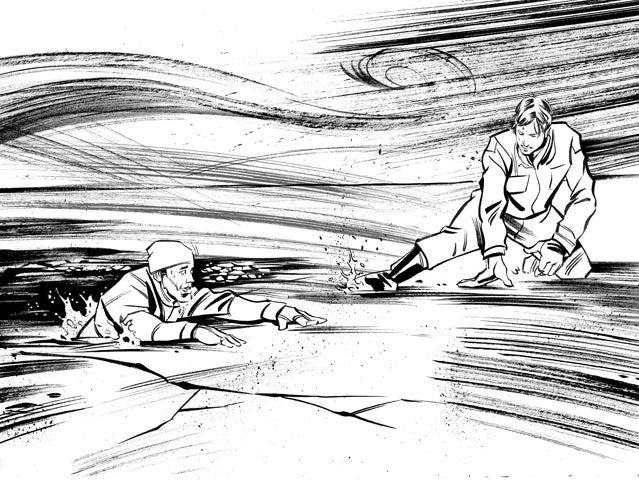
The guys in the bait shop said the ice was solid, a good seven to eight inches—plenty to support a snowmobile—all the way out past an underwater hump called Levi’s Shoal. But when we got there, two guys were already fishing the shoal. My son Aaron and I went to another hump about a quarter-mile in the direction of the open water.
The ice felt thick. The air was crisp, and the coating of new snow sparkled. We went a few hundred yards. The snowmobile slowed. We heard a loud crack, then the sled tilted backward and disappeared beneath us.
Next thing I knew, we were in the water. The hole was about 15 feet in diameter, and I could see Aaron out of the corner of my eye. Instinct told me to help him, but there was nothing I could do from the water. I had confidence in him. He had lost 100 pounds and was now a strong, competent adult. We had both been in poor shape and three years ago decided to start working out. If we hadn’t, each and every week, no excuses, I don’t think we’d be here now. And we knew what to do: we had watched instructional YouTube videos.
When the moment came, Aaron remembered that you’re supposed to “swim” out, meaning flop up onto the surface, instead of putting all your body weight on the edge of the ice and trying to hoist yourself up out of the water. He escaped right away, but I did it wrong—just like the videos warned. The ice cracked again, and I fell back, bobbing in the water. As a piece of ice bumped my shoulder, it occurred to me, This is the real thing; this is how people die.
Then I heard Aaron yelling “Swim! Swim!” And then it was magical, it was very easy.
When I saw that we were both out, we yelled, “Yes!” and moved to firmer ice.
—AS TOLD TO SAM MOULTON
FIVE ALIVE: AVOID BECOMING A HUMAN POPSICLE
Expert advice from polar adventurer Eric Larsen
1. Check the ice as you go. When I’m out, I have an ax with me. If I’m uncertain of the conditions, I’ll stop periodically and give the ice a few good whacks, listening for a deep thump—a good sign it’s solid.
2. Know what to look for. Ice is usually thicker closer to shore, but each lake has its own currents and potential thin spots: springs, river inlets or outlets, outflows from power plants emitting warm water, even beaver lodges.
3. React right away. If you hear the ice cracking, immediately throw your weight backward while spreading out your arms and legs to distribute your body weight. That could prevent you from becoming fully submerged.
4. Gain traction any way you can. Some ice fishermen tie two awls around their neck, just for that reason. Skiers: use your poles as picks; just grab ’em right above the basket. But first you have to take your skis off, because it’s almost impossible to get out with them on.
5. Soak up the water. Once you’ve crawled a safe distance away from the hole, look for fresh, dry snow to rub on your clothes. Light snow is remarkably absorbent, and you want to use it to keep as warm as possible by sucking away moisture.
: Mauled by a Cougar (And Saved by a Bear)
A story so outrageous we had to call the authorities
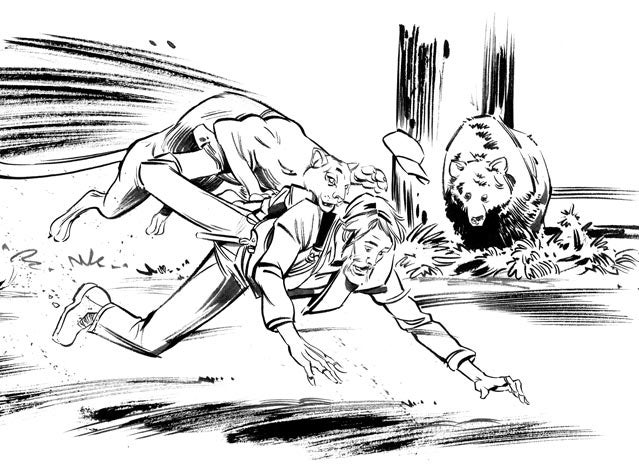
Five days a week, I mine gold on the North Fork of the Feather River, in Northern California, and I’d seen the bear and her yearling there a few times before. So in March, I was surprised when I went down to the riverbank and saw her standing on a gravel bar 45 feet away with the yearling and a new three-week-old cub.1
I turned back up the trail, and three steps later a 120-pound cougar pounced on my back. I never saw it coming, didn’t even suspect it was in the area—I was focused on the bears. Come to think of it, I probably got in the way of that mountain lion’s dinner.2
It came up from behind and pounced on my backpack3, knocking me to my knees. As soon as it was on me, it didn’t let up for a good few seconds. It shook me violently, just like a house cat toying with a mouse.
I swung my rock hammer, which I always carry with me, at its head and heard it howl. When I tried to hit it again, I couldn’t believe what happened. My 400-pound mama-bear friend charged4 and grabbed the cat by its throat, pulling her off me. I crawled into a thicket and watched in awe for nearly a minute. The bear had its teeth around the cougar’s throat, and they were rolling across the ground, hissing and growling.5 Then the cougar twisted free and bolted into the forest.
The mama bear watched the cat retreat and ambled back down to its cubs, which had witnessed the whole affair from the riverbank. As for me, my arm had been scratched bad, so I wrapped it in a rag and hiked back to the car. When I got home, my wife screamed at the sight of me. She tried to make me go to the ER, but I refused. Many people don’t believe this happened to me, but I just ignore them.
—AS TOLD TO MADISON KAHN
FIVE ALIVE: PUTTING THE SCREWS TO A DUBIOUS TALE
An expert opinion from cougar biologist Robert Quigley
1. Mama bears rarely have more than one cub in a span of two years. That’s just bear behavior 101.
2. I can’t recall an incident where a cougar ate a bear cub. I suppose it could happen if the cougar came upon a cub without its mama, but that wasn’t the case here.
3. Cougars aim to kill by going for the head or neck. And the California Department of Fish and Game forensic specialist found no saliva, hair, or bite marks on the pack—all inconsistent with an attack.
4. This is hard to imagine. The only time a female bear might attack is if it felt threatened, and a cougar mauling a miner doesn’t represent a threat to it or its cubs.
5. If a bear and a cat fought, it’d be the cougar doing the biting. Bears use their forepaws to swat things.





